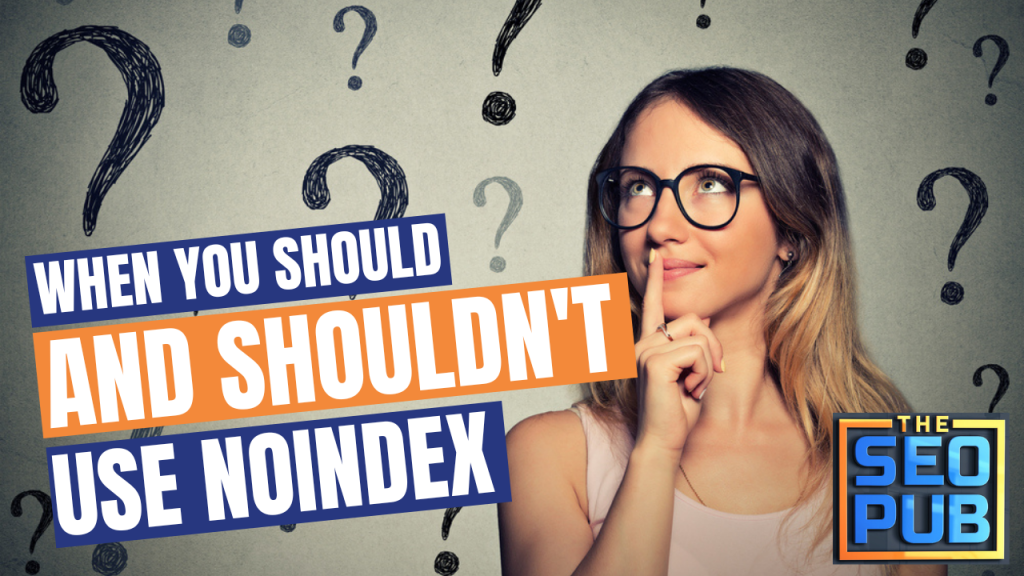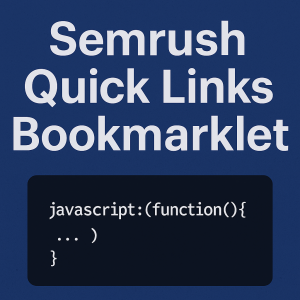
I see the idea of adding a noindex tag thrown around a lot as a band-aid to some common SEO problems. Sometimes it is an appropriate solution, and sometimes it can cause additional problems.
Let’s take a look at some examples of when you should, and more often when you should not, use noindex tags.
Category Pages
The first common, and maybe the most common example I see is in regards to category pages. I did an entire video about this topic last year.
Many times people are worried that a category page is going to outrank the primary landing page they would rather have ranking for a given topic. In order to prevent this, they add a noindex tag to their category pages.
This can cause problems with your internal link structure and cause you to bleed out link equity.
The problem is with how Google will treat links on a page tagged as noindex.
On a Google Webmaster Central office hours hang out a few years ago, John Mueller pointed out that over time, Google will start to treat links on a page tagged noindex as nofollow.
But if we see the noindex there for longer than we think, this page really doesn’t want to be used in search. So we will remove it completely. And that we won’t follow the links, either. And noindex and follow is essentially kind of the same as a noindex nofollow. There is no really big difference there in the long run.
–John Mueller
In other words
<meta name='robots' content='noindex, follow’ />Is equivalent to
<meta name='robots' content='noindex, nofollow’ />Understanding how nofollow works, that means the link equity flows from the page through its links, but never gets credited to any of the target pages. It just vanishes into the ether.
If your category pages are a part of your site structure, i.e. a visitor can reach a category page by following some link path on the site, then you should not use noindex tags on your category pages.
If your category pages are not part of your site structure, i.e. there is no direct link path to reach your category pages and they are completely orphaned, it is safe to noindex them. However, it really does not matter at that point since they are unreachable and not linked to anyhow.
Paginated Pages
This one is very similar to the category page issue. Many times site owners do not want paginated pages showing up ahead of other more content rich pages in the SERPs.
To prevent this, they noindex the paginated pages.
This causes a few problems. First, you will have the same issue as I mentioned above with category pages. Over time, those pages will stop sending ranking signals through the links that appear on them.
Second, it can also cause indexing issues. If web pages are not indexed for a while, search engine spiders will receive a signal to stop crawling their content. If there are no other links leading to that content, it can end up being dropped from the search index as well.
Products Out of Stock
This one is common on ecommerce websites. A product is sold out and will not be returning later. What should you do in this case?
Many ecommerce store owners feel that it may be a bad user experience to have web visitors click on a search result and be a led to a page that says the product is no longer sold.
To combat that, they add a noindex tag to the page to remove it from the search index.
All that hard work to get something ranking and now you want to just remove it because you are worried it might be perceived as a bad user experience? Also, if the page acquired any external links, you are cutting them off by adding noindex to the page.
There are two better solutions to this problem.
The first would be to just put up a message on the page explaining that the product is no longer sold on the site and offer similar products instead, linking to those pages. That way you are not losing the search traffic and still can potentially sell to those visitors.
The other option is to 301 redirect the page to a similar product page. This conserves the link equity from any external links that the page received and will eventually lead to it dropping out of the search index. With this solution, you are at least conserving any offpage ranking signals.
When Should You use Noindex
There are not many cases that I advocate using noindex tags, but there are a few where it makes sense.
Login pages
Hackers often look for login pages in the SERPs so they can try to brute force entry into a website. There is no need for these pages to be indexed.
Marketing landing pages
Landing pages that are designed for other marketing channels can be tagged as noindex and should be completely orphaned from the site so as to not run into the same issue I mentioned on the section above about category pages.
This would include things like landing pages for Google Ads, Facebook Ads, or print advertising campaigns. These pages do not need to follow good SEO practices, and in fact in the case of Google Ads they often perform better if they do not, so there is no benefit to indexing them. They could also cannibalize search results in some cases.
Staging environments
Any kind of a staging environment, whether it is for a complete site redesign or just some ongoing edits and maintenance, should have a noindex tag on every page.
Note: Web designers, please make sure you do not carry over that noindex tag to the live environment. Please.


